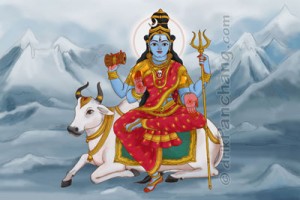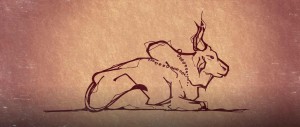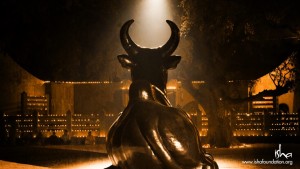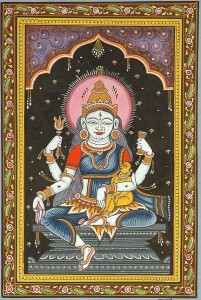माहेश्वरी
माहेश्वरी प्रकृर्तव्या वृषभासना समस्थिता ।
कपाला शुला खटवांग वरदा च चतुर्भुजा ।।
(रूपमंडंना)
माहेश्वरी भगवान शिव की शक्ति हैं जिन्हें महेश्वरा के नाम से भी जाना जाता है। उसके कई नाम हैं; रुद्री, रुद्राणी और महेशी, रुद्र और महेश ये सभी शिव के नाम हैं। उसका रंग सफेद है और उसकी तीन आंखें हैं। उनका वाहन नंदी बैल है, वह सर्प के आभूषण धारण करती हैं और अर्ध चंद्राकार चंद्रमा उनकी जटा-मुकुट में सुशोभित है।
 चतृभुजी:
चतृभुजी:
अपने दो हाथों में वह एक त्रिशूल और एक माला लिए हुए दिखाई देती है। कभी-कभी उन्हें पान-पात्र, कुल्हाड़ी, सर्प या खोपड़ी के साथ भी वर्णित कप किया जाता है। अन्य दो हाथ अभय और वरदान की मुद्रा में होते हैं।
षष्टभुजी:
विष्णु धर्मोत्तर पुराण के अनुसार, देवी माहेश्वरी के पाँच मुख हैं, जिनमें से प्रत्येक में तीन आँखें हैं और प्रत्येक जटा-मुकुट से सुसज्जित है, जिनमें से प्रत्येक पर एक अर्ध चंद्राकार चंद्रमा है। चार हाथों में वह पाश, डमरू, शूल और घंटी, दो शेष हाथ क्रमशः अभय और इच्छा पूर्ति के लिए आशीर्वाद की मुद्रा में होते हैं।
पाठांतर-1
ॐ वृषभ ध्वजाये विदमहे,
मृगा हस्ताय धीमहि।
तन्नौः महेश्वरी प्रचोदयात।।
पाठांतर-2
ॐ अमृत दायनी विदमहे,
महेश्वरी धीमहि।
तन्नौः देवी प्रचोदयात।।
वृषभ की प्रतीकात्मकता:
 गायत्री मंत्र में वृषभ का उल्लेख है जिसके कई अलग-अलग अर्थ हैं। कुछ का यहाँ उल्लेख किया गया है:
गायत्री मंत्र में वृषभ का उल्लेख है जिसके कई अलग-अलग अर्थ हैं। कुछ का यहाँ उल्लेख किया गया है:
वृषभ शब्द के दो अर्थ हैं- एक सरल अर्थ है बैल और दूसरा भगवान शिव का वाहन। सनातन धर्म में सभी चीजों का प्रतीकात्मकता स्वरूप हैं यहाँ भी एक प्रतीक है – एक श्लोक में कहा गया है ‘वृषम भस्ति इति वृषभः’ जिसका अर्थ है “जो सही कर्म को प्रकाशित करता है वह”, इस प्रकार वृषभ ‘सर्वश्रेष्ठता’ का प्रतीक है।
स्वामी शारदाप्रियानंद के अनुसार वृषभ भी प्रतीकात्मक रूप से भगवान शिव की संहारक की भूमिका से संबंधित है। केवल एक साधित आत्मा ही मृत्यु के महत्व को समझ सकती है। मृत्यु पुनर्जन्म की शुरुआत है और यह जन्म और मृत्यु के महान चक्र का केवल एक मामूली हिस्सा है। वृषभ हमें संकेत करता है कि कोई कैसे इस महान चक्र से मुक्त हो सकता है।
निरकुट ने वृषभ का एक और अर्थ बताया है: अत्रि ब्रिहति रेता इति’, “बीज जो अंकुरित हो गया हो़”। साधक को प्रभु की सेवा ठीक वैसे ही करना चाहिये, जैसे कोई साधारण बैल अपने मालिक के लिए बिना कुछ मांगे दिन-रात काम करता है। यदि साधक बिना काम वासना के साधना करने का रवैया अपनाता हैं तो कर्म के बीज को नष्ट कर देता है और वह फिर से पैदा नहीं होगा। जीवन के बंधन से मुक्ति पाने के लिये वृषभ का रवैया सबसे शुभ तरीका हैं।
वेदों में वृषभ बहुल्य सामर्थ्य का धनी या पिता का प्रतीकात्मक रूप है। यह वह है जो चेतना, प्रकृति, गाय की शक्तियों को निषेधित करता है और अपने सामर्थ्य की धारा से दुनिया को जन्म या उत्पन्न करता है। बैल पुरूष – चेतन स्वरूप और गाय प्रकृति- चेतना की शक्ति है।
नंदी – एक चिन्तनशील बैल
 सदगुरु कहते हैं:
सदगुरु कहते हैं:
नंदी अनंत प्रतीक्षा का प्रतीक है, क्योंकि प्रतीक्षा को भारतीय संस्कृति में सबसे बड़ा गुण माना जाता है। जो बस बैठना और इंतजार करना जानता है, वह स्वाभाविक रूप से ध्यान है। नंदी यह उम्मीद नहीं करता है कि शिव कल बाहर आएगे, वह तो बस उनके आने का हमेशा इंतजार करता हैं।
नंदी शिव का सबसे करीबी साथी है क्योंकि वह ग्रहणशीलता का सार है। मंदिर में जाने से पहले, आपके पास नंदी की गुणवत्ता होनी चाहिए – बस बैठने के लिए। आप स्वर्ग जाने की कोशिश नहीं कर रहे हैं, आप इसे या उसे पाने की कोशिश नहीं कर रहे हैं – आप अंदर जाते हैं और बस बैठते हैं। इसलिए, यहां बैठकर, नंदी आपको बता रहा है कि “जब आप अंदर जाते हैं, तो अपने काल्पनिक भावों पर अंकुश रखो, इसे या उसे पाने की माँग ना करों, बस जाओ और मेरी तरह बैठो। ” आपके लिए उसका संदेश है कि – बस अंदर जाओ और बिना नींद के सतर्क बैठो।
अगर आप बिना किसी कार्य-सूची के सिर्फ प्रतीक्षा करते हो, तो अस्तित्व या सत्ता अपना काम करेगा। ध्यान का अनिवार्य रूप से मतलब है कि व्यक्ति अपनी कोई बात नहीं कर रहा है, वह बस वहीं है। एक बार जब आप बस वहां होते हैं, तो आप उस सत्ता के अस्तित्व के बड़े आयाम से अवगत हो जाते हैं, जो हमेशा कार्यरत होता है। आप जानते हैं कि आप इसका एक हिस्सा हैं। अब भी, आप इसका एक हिस्सा हैं। लेकिन यह जानना कि “मैं इसका एक हिस्सा हूँ” यह ध्यान है और नंदी उसी ध्यान का प्रतीक है। वह सभी को याद दिलाता है, “आपको मेरी तरह बैठना चाहिए।”
संदर्भ:
https://hinduism75.wordpress.com
vedapurana.org
www.sanskritimagazine.com/indian-religions/hinduism/sapta-matrikas-the-seven-divine-mothers/
www. templepurohit.com
kaulapedia.com/en/ashta-matrika/
https://sreenivasaraos.com/tag/saptamatrika/
Article Spirituality & Mysticism : Sadhguru and Shekhar Kapur discuss the significance and symbolism of Nandi
Photo: Drikpanchang.com
www.Ishafoundation.org
Google search
Maheshwari
Maheshwari prakrartavya Vrishabhasana samasthita,
Kapala shula khatvanga varada cha chaturbhuja ।।
(Rupamandana)
Maheshwari is the power of God Shiva who is also known as Maheshwara. She has many names; Raudri, Rudrani and Maheshi, all of them derived from Shiva’s names Rudra and Mahesh. Her complexion is white and she has three eyes. Her mount is Nandi the bull. She is adorned with serpent bracelets, a crescent moon and the Jata-mukuta.
 When she is depicted with four hands:
When she is depicted with four hands:
In her two hands she is seen carrying a trident and a rosary. Sometimes she is seen carrying a goblet, an axe, a serpent or a skull cup. The other two hands are in the pose of bestowing fearlessness and boons.
When she is depicted with six hands:
In Vishnu dharmottara Purana, Goddess Maheshwari has five faces, each possessing three eyes and each adorned with Jata-mukuta crown, a crescent moon on each of them. In four of the hands she carries the thread, a damru, a prong and a bell, the two remaining hands being respectively for blessing with fearlessness and desire fulfilment.
Version 1
Aum Vrushabha dhwajaaya Vidmahe,
Mruga Hastaya Dhimahee,
Tanno Maheshwari Prachodayat ।।
Version 2
Aum Amrita daayani Vidmahe,
Maheshwari Dhimahee,
Tanno Devi Prachodayat ।।
Symbolism of Nandi:

The Gayatri Mantra mentions ‘vrishabha’ which has many different symbolisms. A few are mentioned here :
The word Vrishabha or Vrushabha, has two meaning. A simple meaning is the bull, the vehicle of Lord Shiva. But there is another hidden symbolism in it.
A shloka says ‘vrsham bhasyati iti vrishabha which means “one who illumines right actions”, thus symbolising ‘the best’.
According to Swamini Saradapriyananda Vrishabha is also symbolically related to Lord Shiva’s role of a destroyer. Only a realized soul can understand the significance of death. Death is the beginning of regeneration and it is only a miniscule part in the great cycle of birth and death. The Vrishabha indicates how one can get liberated.
Nirkuta derives another meaning for Vrishabha: ‘Atribrihati reta iti’meaning, “roots out of the seed”. When a seeker serves the Lord faithfully, just as an ordinary bull serves his master day in and day out, without demanding or seeking anything for himself, then this very attitude destroys the seed of karma and he will not be born again.
The Vrishabha attitude is the carrier of the most auspicious of all, the release from the bondage of life.
Vedas describes that ‘Vrishabha’ is symbolic as the father of abundance. It is he who fertilizes the forces of Consciousness, Nature, the cow and produces or bears in his stream of abundance the worlds. Bull is the Purusha, the conscious being and cow is the Prakriti, the power of consciousness.
Nandi – The Meditative Bull
 Sadguru says: Nandi is a symbolism of eternal waiting, because waiting is considered the greatest virtue in Indian culture. One who knows how to simply sit and wait is naturally meditative. He is not expecting Shiva to come out tomorrow. He will wait forever.
Sadguru says: Nandi is a symbolism of eternal waiting, because waiting is considered the greatest virtue in Indian culture. One who knows how to simply sit and wait is naturally meditative. He is not expecting Shiva to come out tomorrow. He will wait forever.
Nandi is Shiva’s closest accomplice because he is the essence of receptivity. Before you go into a temple, you must have the quality of Nandi – to simply sit. You are not trying to go to heaven, you are not trying to get this or that – you go inside and simply sit. So, just by sitting here, he is telling you, “When you go in, don’t do your fanciful things. Don’t ask for this or that. Just go and sit like me.” That’s his message for you. Simply go inside and sit, alert, not sleepy.
If you just wait without doing your own thing, existence will do its thing. Meditation essentially means the individual is not doing his own thing. He is just there. Once you are simply there, you become aware of the larger dimension of existence, which is always in action. You become aware that you are a part of it. Even now, you are a part of it. But becoming aware that “I am a part of it” is meditativeness. Nandi is the symbolism of that. He reminds everyone, “You must sit like me.”
References:
https://hinduism75.wordpress.com
vedapurana.org
www.sanskritimagazine.com/indian-religions/hinduism/sapta-matrikas-the-seven-divine-mothers/
www. templepurohit.com
kaulapedia.com/en/ashta-matrika/
https://sreenivasaraos.com/tag/saptamatrika/
Article Spirituality & Mysticism : Sadhguru and Shekhar Kapur discuss the significance and symbolism of Nandi
Photo: Drikpanchang.com
www.Ishafoundation.org


